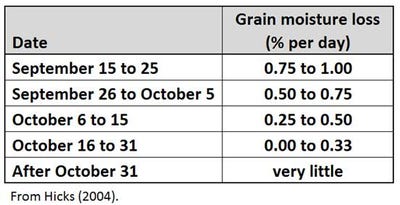September 16, 2011

Much of Minnesota's corn crop was damaged by frost on Sept. 15. For corn, a killing freeze occurs when temperatures are 32° F for four hours or 28° F for minutes (Figure 1). A frost or killing freeze can still occur when temperatures are above 32° F, especially in low and unprotected areas when there is no wind.
Symptoms of frost-damaged corn
Corn leaves are more easily damaged by frost than stalks. In addition, leaves above the ears are more susceptible to injury than leaves below the ear. Leaves damaged by frost initially have a water-soaked appearance, are light green to gray after drying, and later turn brown. Kernels that are killed prior to physiological maturity by an early freeze will have a black layer form prematurely (Nielsen, 2002). It is recommended to wait a few days before scouting fields to assess the impact of frost. If the frost is not severe enough to cause premature formation of the kernel black layer, the kernels will continue to accumulate dry matter through translocation of sugars from the stalk and remaining green leaf area (Carter and Hesterman, 1990).
Corn in Sibley County, MN, was at the R5.3 kernel stage (kernels 70% milk) when the frost occurred. Corn leaves were dark green the day before. Leaves above the ear were damaged, and were gray to light green and dry at eight hours after the frost. The stalk and leaves below the ear were not damaged. Husks were tightly wrapped around the ears.
Yield, moisture and quality
Frost damage to corn reduces grain and silage yields, grain test weight and silage quality (Table 1). However, these yield and quality reductions depend on the crop stage when frost occurs and the severity of the frost. If leaves above the ear are damaged by frost but leaves below the ear are unharmed, then yield losses are expected to be slightly less than those listed in Table 1 for leaf damage only.

The dry conditions that occurred during the last four to six weeks in much of Minnesota accelerated crop maturity. Most of the corn that was planted during the first three weeks of May was beyond the half-milk kernel stage (R5.5) when damaged, and therefore grain yield losses in these fields are expected to be low. However, in regions where corn was planted in late May or early June, the corn was around the R5.75 stage (25% milk) when damaged.
Corn that is severely damaged by frost often has kernels that are more susceptible to cracking, grain that is less digestible and silage that has less energy (starch) and more fiber than normal. Grain with severe frost damage and light test weight should be monitored for mycotoxins before feeding to livestock.
Typical in-field drydown rates for corn grain in Minnesota are listed in Table 2. Thus, if a killing freeze occurred on corn at the R5 stage (dent and 60% grain moisture) on Sept. 15, then that corn is expected to have over 38% grain moisture on Nov. 1. In comparison, if a killing freeze occurred on corn at the R5.5 stage (half milk and 40% grain moisture) on Sept. 15, then that corn is expected to reach 25% grain moisture on Oct. 6. Fields where the husks were green and tightly wrapped around the ears at the time of a killing freeze will dry slowly, and ears in those fields should be monitored for mold. In contrast, corn that was more advanced in maturity at the time of the frost (husks opening up and turning brown) will dry more normally.
You May Also Like




